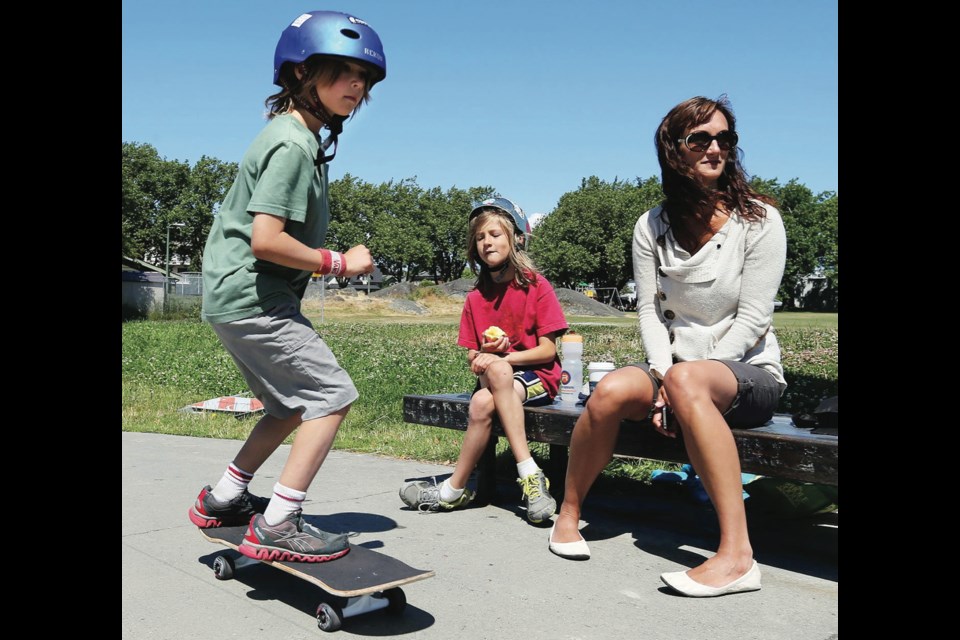Tamara Lukie once went through 18 Band-Aids in one day after her two sons, Callym and Oscar, started skateboarding.
But as far as Tamara is concerned, cuts, scrapes and bruises are just part of boyhood.
“Boys are going to hurt themselves no matter what they do,” said the James Bay mom. “They get hurt doing homework.”
But while Tamara isn’t overly concerned about skateboard scrapes and bumps, she is adamant about helmets. If Callym, 10, and Oscar, 8, want to get on their boards, they must first put on their helmets.
“They don’t leave the house with their boards without their helmets,” she said at the municipal skateboard park in Vic West.
Skateboarding has undergone a transformation since the 1980s and early ’90s. Back then, the activity was seen as something counterculture, almost underground.
Now, skateboarders, at least the good ones, don’t terrorize seniors on sidewalks or create hazards for traffic.
Instead, they reserve their most extreme tricks for the designated parks, built with concrete slopes, ramps, jumps and railings to perform, practise and perfect tricks.
Dr. Richard Stanwick, Vancouver Island regional medical health officer, said he encourages parents and children to take up skateboarding. But he also insists on safety.
A proper-fitting and approved helmet is absolutely essential. Pads to protect knees, elbows and wrists are also recommended.
Stanwick said Canadian numbers aren’t available, but in the U.S., skateboard accidents account for 50,000 visits each year to hospital emergency rooms for 12- to 17-year-olds. Canada’s numbers are likely about 10 per cent of that. Stanwick noted a fall of only about 40 centimetres has been enough to cause a fatal accident.
Skateboarding can also reach speeds similar to those of skiing and hockey, so it makes sense to wear the same sort of protective gear, especially for the head. “Our noggins really do need protection,” Stanwick said. “We recommend helmets for skiing and hockey, and certainly skateboarding falls into the same category.”
On the other hand, Stanwick said he is delighted to see young people enjoying skateboarding.
“When you see the fitness levels that some of these kids achieve to do their tricks, we would have to encourage it as a physical activity,” he said.
Skateboards now come in a variety of types and sizes, from small “penny cruisers,” often constructed out of plastic to the relatively new longboard, mostly used for travel on streets and sidewalks, and the standard plywood skateboard with the upturned ends that facilitate tricks.
As an activity, skateboarding has become almost mainstream, although users are still banned from skateboarding in certain parts of downtown — something a Victoria man who had his skateboard seized by bylaw officers for boarding downtown is trying to reverse through an online petition.
Municipalities in Greater Victoria have constructed special parks for skateboarders to perform. Hired supervisors oversee these parks in the same way lifeguards oversee neighbourhood swimming pools.
Skate parks also operate with a code of conduct to ensure everybody can have fun without intruding on anyone else. These rules of etiquette operate in the same way as on ski hills.
Most municipalities even hold instruction camps for various ages and stages to learn about skateboards before stepping into a park. This gives youngsters a chance to learn the basics and the etiquette required for enjoying a skateboard park with others.
“It’s definitely a legitimate sport,” said Ryan Lance, child and youth recreation programmer for the City of Victoria.
Brandon (Brando) Wells, a 20-year skateboarder and employee at Coastline Surf and Sport on Broad Street, said a safe start in skateboarding is relatively inexpensive.
Prices vary, but a good beginner’s board can be purchased for as little as $109. A set of pads goes for about $40 and a helmet starts at $49.
Wells said as a young person, he played competitive hockey and suffered far worse injuries playing that sport than skateboarding.
He recommends beginners start with a skateboarders’ camp to learn the basics and then start to have fun.
“It’s a legitimate activity,” Wells said. “Let’s turn the TV off, turn the video games off and let’s get outside.
“And it’s so individual,” he said. “You can go at your own pace and do whatever you want. Whatever you do, the most important thing is what puts a smile on your face.”
Capital Regional District municipalities offer skateboarding courses for youngsters, from one-day introductions to week-long camps.
• Saanich offers courses at its skateboard park at the Gordon Head Recreation Centre, 4100 Lambrick Way. Call 250-475-7100 or go to saanich.ca.
• Victoria offers skateboard camps through Crystal Pool and Fitness Centre, 2275 Quadra St. 250-361-0732.



